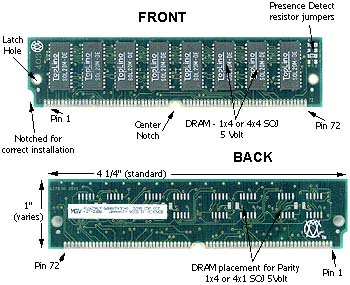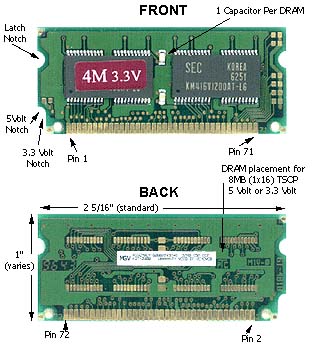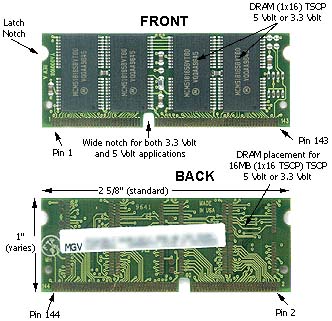|
TYPES
OF MODULES
SIMM is an
acronym for Singe Inline Memory Module. A SIMM is
a circuit board containing memory chips (DRAMs) which plug into a computer's motherboard.
The most common SIMMs are 30Pin and 72Pin.
- Note: 30Pin
SIMMs are typically 8-bit (non-parity)
or 9-bit (parity).
- Note: 72Pin SIMMs are typically 32-bit (non-parity)
or 36-bit (parity).
30Pin SIMMs or 72Pin
SIMMs must
be determined. 486 based systems
normally .need four 30Pin SIMMs for the same capacity, while you only need a single
72Pin SIMM. Pentium based systems require upgrades of two 72Pin SIMMs at a time.
- Note: It
is important to read the system board
manual to verify the upgrade
path.
DIMM is an
acronym for Dual Inline
Memory Module. Now that
64-bit processors are becoming the standard, system designers are moving from
using two 72Pin SIMMs to a single 168Pin DIMM.
- Note: Please
refer to DIMM OVERVIEW for further
explanation.
COMPOSITE VS. NON-COMPOSITE
SIMMs AND DIMMs
1.
Composite SIMMs/DIMMs are double sided. This
does not always apply.
2. Composite
SIMMs/DIMMs use 4Mbit DRAM. This does not always apply.
3. Composite DIMMs/DIMMs
are double-bank. This always applies.
1 . Non-Composite SIMMs/DIMMs are double sided.
This does not always apply.
2. Non-Composite SIMMs/DIMMs use 16Mbit DRAM. This does not always apply.
3. Non-Composite
SIMMs/DIMMs are single-bank. This always applies.
NON-PARITY, PARITY, AND ECC
Non-Parity
memory is the most
commonly used module in the market
today. It gives the complete function of parity memory, but at a lower cost. 85%
of all systems shipped in the world today use non-parity memory. Non-Parity has
nothing to do with the type of DRAM used.
Parity memo
was used more often
in the past due to the unreliability
of DRAMs being shipped. It offered no functionality to the system, but to inform
you of a possible error with data transfer
in memory. With better
reliability with DRAM production
and cost conscious customers, parity has almost been eliminated altogether.
- Note:
Some
systems are still using parity to generate
ECC off of the system
board.
- Note: Some vendors ship parity generation that
is a substitute for real parity.
Parity generation will work in most cases except when trying to generate ECC or
upgrading some UNIX and Novell based operating systems.
- Note: Some vendors ship Quad-Cas parity that
is
true parity but is not 100%
compatible. This was designed to use fewer chips and reduce cost.
ECC (Error Code & Correct)
is used to correct
single bit errors that can occur during memory addressing. This is becoming more
main stream, as systems require larger amounts of memory and operation systems
become memory intensive.
- Note:
Intel
is planning to put this function into
the future generation of
processors to better handle memory. Currently it is a function of the system chip-set.
Ns (Nanosecond)
The speed in which the module reads and writes
is measured in nanoseconds.
naturally the lower the number the faster the module performs these functions.
In most cases, you can mix faster memory (60ns) banks with slower memory banks
(70ns), but the faster modules will only be as fast as the slowest memory bank.
30 Pin SIMM (2/3 Chip Design)
1 or 3MB, Non-Parity or Parity

72 Pin SIMM (8 or 12 chip)
4 or 16MB Non-Parity or Parity

72 Pin SIMM (8 or 12 Chip Design)
4 or 16MB Non-Parity or Parity

72 Pin SODIMM (2 or 4 chip)
4 or 8MB Non-Parity 3.3volt or 5 Volt

144 Pin SODIMM (4 or 8 chip)
8 or 16MB Non-Parity 3.3Volt or 5Volt

168 Pin DIMM (4 or 8 chip)
8 or 16MB, Non-Parity, 5 Volt Buffered

168 Pin DIMM (16 or 18 Chip)
32MB Non-Parity or ECC, 5Volt or 3.3Volt, Non-Buffered

| Home
| Company Info | Manufacturing
| MGVision |
| Product Information | Product
Support | How To Become A Reseller |
| What's New | Where To Buy
|

Copyright © 1996-1997
|